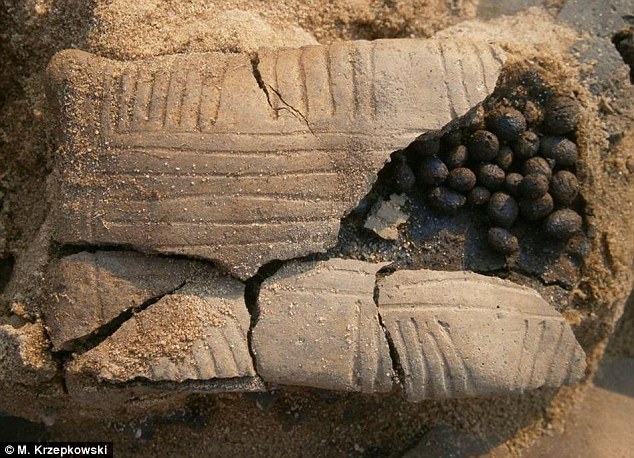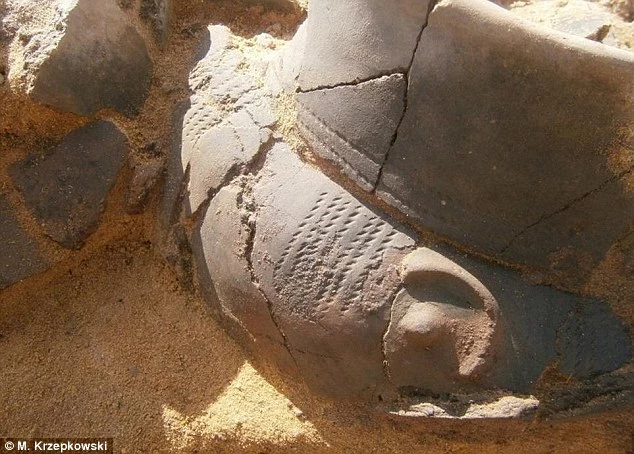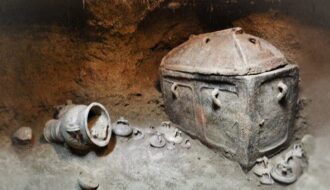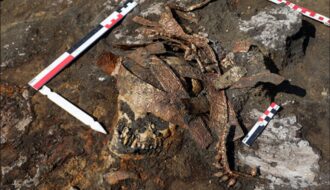The 2,500-year-old baby grave that still contains a toy rattle made of clay
In a mass grave in Poland, tiny urns containing the remains of babies cremated two and a half millennia ago were uncovered.
Archaeologists discovered the remains of thousands of settlers buried in 150 graves, or ‘pit tombs,’ while excavating a cemetery in the Polish village of Łęgowo near Wągrowiec.

These tombs were common during the late Bronze Age, when members of Lusatian culture across Eastern Europe were cremated upon death and buried together in urns, with some ashes being offered as gifts to the gods.
These urns were understood as ‘vessels’ that took the deceased on their ‘last journey’, claimed lead archaeologist Marcin Krzepkowski. When one person died, their ashes were stored in an urn and placed in a designated ‘pit tomb’ within a cemetery.
As more people died, the urns were grouped together until the tomb was full. It would then be covered over and the urns would be buried. If members of the same family died before the tomb was covered over, they would be added to the same tomb.

Families would also choose tombs, in a similar way funeral plots are allocated today. This means the child graves discovered by Krzepkowski could have been surrounded by the parents and relatives of the child, or put in a mass grave with others from the same community.
Krzepkowski added family members would decorate urns with elaborate patterns, or bury their loved ones with various clay gifts – such as the rattle that was found – to send them on their way to the gods.
Many of the elaborate urns were decorated with images that depicted the Lusatian way of life, including horse riding and agriculture. The people of the Lusatian culture were believed to be mainly cattle, pig and goat farmers.

Among the remains discovered in Łęgowo, Krzepkowski also found bronze items including pins and a sickle, plus what appeared to be an early razor.
In one grave, Krzepkowski found a tiny urn next to an early baby’s rattle in the shape of a pillow made from clay and filled with small balls. Traditional burials were rare in the Lusatian culture and almost all the settlers would have been cremated.
Krzepkowski told MailOnline: ‘In Bronze Age the custom of burning the dead people spread over most of Europe, including the current territory of Poland.
‘From this period, and from the early Iron Age, we know of many cemeteries contained hundreds or even thousands of pit tomb.’
He added the custom was more than likely due to people during this period having ‘solar beliefs’ and worshipping the sun.
The ashes were usually placed in urns and these were covered with a bowl lid before being turned upside down.Dozens of urns would then be placed in the ground in the same locations to create ‘grave pits.’
During Krzepkowski’s excavations he found one pit contained as many as 40 urns filled with ashes, plus various gifts.
In another grave containing the remains of what appeared to be a child, Krzepkowski discovered a spoon with a handle shaped like a bird. While a third contained a decorated bowl with a small bird-like figure inside.
‘A quite unique discovery in this part of the Poland is a small rectangular clay object, associated with the cult of hearth and home, so-called moon idol,’ explained Krzepkowski.
He continued that such objects are usually found in Silesian cemeteries, mostly from the area of Wrocław around 136 miles south of Legowo.

The Lusatian culture spread from Poland, into the Czech Republic and Slovakia as well as parts of East Germany during the late Bronze Age and early Iron Age.
In 1933 Polish archaeologists discovered remains of a Bronze Age settlement in Wielkopolska (Greater Poland) which later became known as Biskupin and was among the first excavations of a Lusatian culture settlement. Another was found in Buch near Berlin.
Both sites contained open villages with fortified settlements made up of wooden boxes filled with soil or stones. The forts were built on top of hills, or in swamps, and cemeteries were created nearby.
It is believed that the graves found in swampy areas were full of ‘gifts to the gods’ – a place where settlers who had been sacrificed would be placed.
What is believed to be sacrificial pits found in Bradenburg in Germany were found to contain human bones buried as deep at five metres.

Records written by Polish priest Jan Długosz in the fifteenth century were the first to mention the cemetery found near Wagrowiec.
According to Science and Scholarship in Poland, the notes said: ‘born from the womb of the earth are pots, by themselves, only by the art of nature, without any human helping, of all sorts of different shapes, similar to those people use, though delicate and soft, while still rooted in their family soil in the ground, yet when they are removed they become tight and hardened in the sun or wind.’
The site location was then pinpointed to the village of Legowo in the 19th Century. The work was carried out by the Regional Museum in Wągrowiec.
Ancient Archaeology




